Final Report for FNE13-781
Project Information
This project investigated three cover crops (buckwheat, phacelia, and a perennial conservation mix from Ernst Seeds) for enhancing pollinator floral resources on farms. Results showed that both buckwheat and phacelia functioned well as cover crops and enhanced floral resources especially during seasonal floral resource dearth periods. Honeybees preferred buckwheat while bumblebees preferred phacelia. In our planting situation, the conservation mix was not competitive with weeds until the second year when Maximillian’s sunflower dominated and provided a late September and October floral resource for pollinators. Highlights of our outreach involved multiple pollinator workshops, a field day, and a video (Enhancing Pollinator Floral Resources at The Farm Between) available at The Farm Between website: (www.thefarmbetween.com) and on Youtube.
Introduction:
In the Northeast, most fruit crops and many vegetable crops depend on insect pollinators for optimal fruit set and yield. Unfortunately, honeybee and native pollinator populations are on the decline. Multiple factors including pesticide use, habitat loss and disease and parasites are to blame. We had noticed a decline on our farm over the past 20 years and a few years ago started working proactively to provide habitat and floral resources to help pollinator populations rebound. We grow many varieties of tree fruit and berries and are expecting a return on our habitat improvement investment in terms of increased yields, more biodiversity, and improved pest management from beneficial insects and birds. The purpose of this grant was to investigate how cover crops could be used to provide pollinator habitat while still providing other functions (for example, building organic matter and weed suppression).
After doing a farm habitat analysis to observe the timing of flowering plants and their abundance over an entire growing season, we saw a floral resource gap or ‘dearth’ in July and August. This has also been noted by Vermont beekeepers. Most of our tree fruit and berries flower in spring and early summer and we keep large areas unmowed to encourage goldenrod and asters that flower in late summer and fall. Cover crops are one way to provide bee forage during this July and August ‘dearth’ period. Cover crops are traditionally used to build soil organic matter, prevent erosion, suppress weeds, and scavenge nitrogen. We added to this multi-purpose list the importance of providing valuable pollinator and beneficial insect floral resources. We had some potential cover crops to evaluate for this attribute. We were also interested in planting insectary plants that benefit predatory and parasitic beneficial insects. The cover crops used in our study were buckwheat, phacelia and an Ernst bee forage mix.
The goal for 2013 was to establish cover crop plots and collect data on pollinator, beneficial and tarnished plant bug populations as well as flowering phenology and weed populations. In 2014 we finished collecting data on cover crops as potential weeds and focused on analysis of data, demonstrations and other outreach.
Cooperators
Research
The cover crops in our study were buckwheat Fagopyrum esculentum, phacelia Phacelia tanacetifolia, and a bee forage mix by Ernst. The make up of the Ernst mix (www.ernstseed.com) is shown in Table 1.
To evaluate Phacelia's attributes and to learn more about buckwheat and a bee forage mix, we made two plantings over the 2013 growing season, early and late summer (June 5 and August 7). We originally planned to have an early spring planting, but wet spring weather prevented this early planting in 2013. Instead, we put in an early planting in 2014 to see how the buckwheat and phacelia would do under earlier planting conditions. Each of the 2013 plantings had three replicates of each cover crop for a total of nine plots. Individual plots were 160 square feet (8' x 20') set up in a randomized complete block design. We blocked to account for different weed populations within the plots and to keep time of day and weather during data collection similar (one block at a time). The area containing the research plots was previously planted to mixed vegetables (two prior years) and had a strong weed seed bank. The plots were prepared with two passes of a walk behind rototiller a few days before planting. Seeding was done by hand broadcasting half the amount at a time in each of two directions. Buckwheat was seeded at an equivalent of 50#/acre, Phacelia at 12#/acre, and the Xerces Northeastern bee forage mix from Ernst Conservation Seeds at 10#/acre. After seeding, the plots were raked to spread and bury the seeds. We carried the research over into a second year to determine the potential for self-seeding in these plots and to further evaluate weed suppression.
Native pollinator and honeybee populations were observed by setting up a permanent three square foot quadrangle in each plot and observing each quadrangle for five minutes on a weekly basis or as soon as the weather permitted (above 55 degrees, no rain). Other beneficials such as parasitic wasps, lacewings, ladybugs and pests such as tarnished plant bug were sampled by 20 sweeps of a standard sweep net/plot around the perimeter after the observation work was finished.
Flowering phenology was observed weekly. Original plans to collect data on stems/square foot and flowers/stem was too labor intensive, so percent bloom was visually estimated as percentage of buds flowering. Flowering phenology of our fruit crops was also observed. Weed observations were conducted twice during the season for each plot. Weeds were counted in randomly chosen moveable square meter quadrangles in each plot. Species and density was noted. Cover crop reseeding potential was checked in 2014 by determining the number of stems (by plant species for the bee forage mix) per ft2 in midsummer.
Photographing bees and insects on the various plants in different plots was also done. We tried to use some time lapse photography, but the results were not satisfactory.
We were able to establish two successful buckwheat and phacelia plantings in 2013. Due to weed pressure, the commercial bee forage mix was not as successful. Honey bee and native bee populations were plentiful and data on pollinator visits were collected as planned. Tarnished plant bug populations were also monitored and were plentiful.
We learned that both phacelia and buckwheat are easy to grow cover crops in our climate. They established well and were competitive with weeds but not significantly different from each other (P=0.1). This is shown in Figure 1. There were no volunteer buckwheat or phacelia plants in any of the plots in 2014. Unfortunately our bee forage mix did not establish well except for the Maximillian’s sunflower (Helianthus maximilianii) and some lupine (Lupinus polyphyllus). The rest of the species in the mix were outcompeted by broadleaf annual weeds, especially galinsoga. This showed us that we need to rethink our planting strategy for this perennial mix to include pre-planting weed control. During 2014, the Maximillian’s sunflowers came back in full force, suppressing weeds and providing late fall floral resources for bees, butterflies and other insects after the traditional goldenrod/aster bloom.
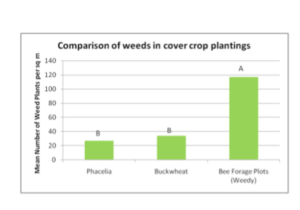
The timing of the planting affects flowering time and we found that phacelia planted on June 6 began to flower on July 17 (41 days) and peaked at 70% bloom on Aug 19 (69 days). Percent bloom of phacelia is shown as the purple dashed line in Figure 2. Although diminished, there was still some bloom available for foragers until the end of September (not shown in Figure).
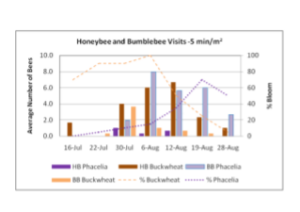
Buckwheat was faster to flower, peak, and dry down. Buckwheat planted on June 6 began to flower around July 8 (29 days), peaked around Aug 6 (61 days) and blooms were finished by Aug 28 (89 days). This is shown as the orange dashed line in Figure 2. In the bee forage plots, only the Maximillian’s sunflower bloomed and not until the beginning of September. Our August 7 plantings were too late to have much of an impact on pollinators; when they finally bloomed in September, goldenrod and aster were in full bloom and very competitive.
We also learned that honeybees prefer buckwheat (Figure 3)
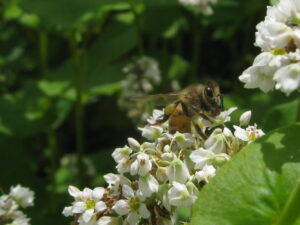
and bumblebees prefer phacelia (Figure 4)
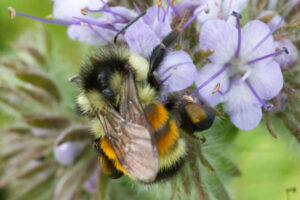
when both blooms are available to choose from. This is shown graphically in Figure 5. Note that even when the buckwheat was at nearly 100% bloom and the phacelia was about 18% bloom, the bumblebees still preferred the phacelia.
Figure 5 summarizes the means of the insect visit data for the different plots and dates, and shows that there was a statistical difference (P=0.1) in terms of plant/flower preference among the different insects. Figure 5 also shows the results of Syrphid fly counts. Syrphids preferred the galinsoga in the weedy bee forage mix plots over buckwheat or phacelia.
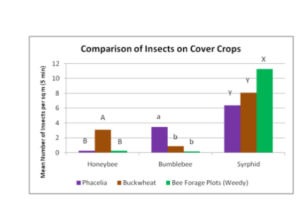
Another interesting finding was that the tarnished plant bugs (TPB) also preferred phacelia (Figure 6) while having a low preference for buckwheat. The bee forage mix plots also showed a fairly high amount of adults due primarily to galinsoga in the weedy plots. There was a statistically significant difference in the TPB population found in each type of cover crop.
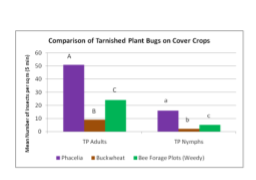
Figure 7 and 8 show the adult and nymph populations (respectively) over time in the various plots. The adult TPB population was high in the early season and the nymph population increased over the season. Phacelia is clearly preferred over the other two. The TPB also preferred the bee forage mix (weedy) plots over the buckwheat.
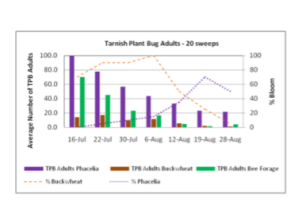
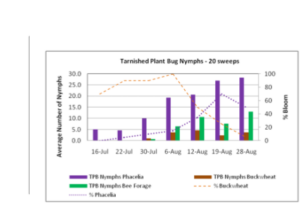
Education & Outreach Activities and Participation Summary
Participation Summary:
In support of our on-farm outreach we planted demonstration plots of buckwheat, phacelia, Ernst bee forage, yellow rocket, borage, mustard, summer alfalfa and chickling vetch. We also had separate plantings of buckwheat and phacelia cover crops as part of our farm operation.
A summary of outreach events are presented in Table 2. The results of our SARE grant have been included in presentations, pollinator walks and workshops, and articles. Cover crops offer a multi-functional opportunity for land management that enhances pollinators and the research results are duly shared in our pollinator outreach.
Table 2. Summary of pollinator outreach highlights that included reference to the results and information garnered from our SARE Grant.
Table 2
|
Date |
Activity |
Approximate # Reached |
|
7/1/2014 |
Pollinator Workshop organized by the Vermont Land Trust. Three hour pollinator workshop between The Farm Between and Riverberry Farm. |
25 |
|
7/8/2014 |
Pollinator Workshop at Hildine. |
35 |
|
7/19/ 2014 |
SARE Field Day – Two hour workshop on pollinators and cover crops to enhance pollinator populations. |
30 |
|
8/25/2014 |
Pollinator Walk at UVM. |
35 |
|
9/9/2014 |
Intervale Pollinator Walk. Two hour walk and lecture on pollinators. |
30 |
|
2/4/2015 |
Presentation to the Stowe Garden Club on Edible Landscaping for People and Pollinators. |
30 |
|
2/16/2015 |
VT NOFA Intensive on Enhancing Pollinator Populations in Your Working Landscape. |
25 |
|
2/16/2015 |
Article for On Pasture On-line Article entitled “Cow Pies and Apple Pies,” that focused on pollinators and pasture management including cover crops. |
100+ |
|
2/24/2015 |
Included link to mySARE site related to our grant on The Farm Between website. |
We estimated several hundred people will view these links over the coming months. |
|
3/4/2015 |
Video uploaded on youtube and The Farm Between website. |
|
|
3/2015 |
Final report pdf located on our website. Included on facebook page as well. |
Some of the highlights were the two field days on our farm where we shared our data and visited our SARE plots. On June 30 in partnership with the Vermont Land Trust, 20 people attended our workshop on how to create pollinator habitat for small scale farms and gardens. On July 29th in coordination with UVM extension, we held a SARE Field Day farm and plot tour focusing on creating on-farm habitat for pollinators. A mix of approximately 25 Extension personnel, farmers, researchers and students met at The Farm Between and visited our research plots and other pollinator habitat demonstrations.
We also presented some of our first year data at the 2014 NOFA Winter Conference (60 people). As a result of our NOFA workshop, we were asked to conduct a full day intensive on Pollinator Habitat Enhancement at the 2015 NOFA Winter Workshop (25 people).
Over 100 farmers, gardeners, extension personnel, and students were made aware of the potential benefits of cover crops as pollinator habitat and were introduced to phacelia as a cover crop. The final report will be posted on our website and will continue to educate people about cover crops and pollinators.
We developed a Video summary of our work with the help of Heather Darby and Amanda Gervais from UVM Extension. It can be seen on The Farm Between website: (https://www.thefarmbetween.com) and on Youtube Enhancing Pollinator Floral Resources at The Farm Between (https://www.youtube.com/watch?v=mO5wMI1uauM). We were not able to do time lapse videography of the plantings as planned due to lack of functioning equipment.
A press release was written and sent to the following local papers: Burlington Free Press, Stowe Reporter, and The Transcript on February 24th 2014.
Project Outcomes
Future Recommendations
We are intrigued by this research and will continue to experiment with cover crops as pollinator resources. From the information we gathered, we are planning to experiment on the design of an annual cover crop mix of phacelia, buckwheat, mustard, forage radish, and annual sweet white clover to try to have season long flowering in combination with all of the other positive attributes of cover crops. We appreciate the support of our work by NESARE and hope you will continue to fund grants that concern pollinator conservation in the future.